
Permissible alcohol limit in ppm: up-to-date information
Content
Since ancient times, it has been known that alcohol consumption greatly affects the reaction rate and mental state of a person. For this reason, the Rules of the Road prohibit driving under the influence of alcohol, establishing severe sanctions for this violation. Therefore, it is very important to understand the established standards and rules for examination, so that by an unfortunate mistake you do not lose your rights.
What is ppm
When determining small quantities or parts of some objects and substances, it is quite inconvenient to use integers. To simplify calculations, people began to use first parts of a number, for example, 1/8, and then a special% sign, which denoted 1/100. Finally, for cases requiring even greater precision and reflection of the smallest details, ppm was invented. It is a percent sign, padded with another zero at the bottom (‰).

The term "per mille" means 1/1000 of a number and comes from the Latin expression per mille, meaning "per thousand". The term is best known for measuring the amount of alcohol in a person's blood. However, it should be noted that as of the current legislation, the alcohol content in exhaled air is measured in other units: milligrams per liter. In addition, ppm is used to display the salinity of the seas and oceans, the slope of railways, and many other phenomena that represent small values.
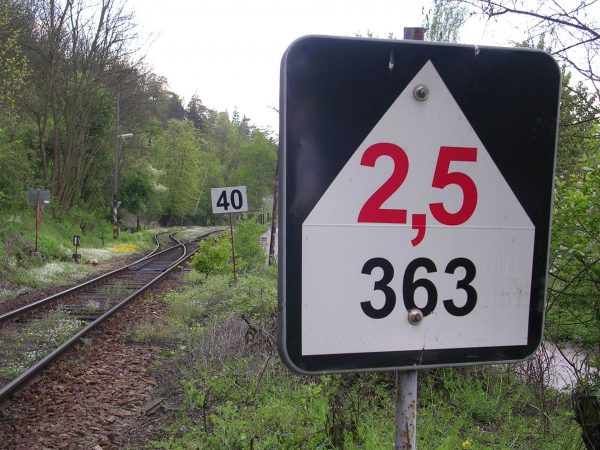
Finally, to finally clarify the simple mathematical content of the term under discussion, I will give a few examples:
- 15‰=0,015%=0,00015;
- 451‰=45,1%=0,451.
Thus, ppm helps to give calculations with small fractions a form convenient for human perception.
The permitted amount of alcohol in the blood for motorists in Russia for 2018
In recent years, in our state, the approach of the legislator to the permissible volume of alcohol in the blood of a car driver has already changed. Until 2010, the law allowed the content of pure alcohol in the blood up to 0,35 ppm and in the exhaled air - up to 0.16 milligrams / liter. Then this period was replaced by an extreme tightening of state policy for three years. From 2010 to 2013, any ethyl content in the body exceeding 0 was punished. Even for one hundredth of a ppm (adjusted for instrument error), it was quite legal to receive an administrative penalty.
To date, according to the note to Article 12.8 of the Code of Administrative Offenses, the amount of alcohol in a mixture of gases exhaled by a person should not exceed the same 0,16 milligrams per liter. Any breathalyzer indicators below the given are not recognized as confirmation of the state of alcoholic intoxication. On April 3, 2018, the President of Russia signed a law on amendments to Article 12.8 - the norm for the content of pure alcohol in the blood is now allowed at the level of 0,3 ppm. This rule comes into effect on July 3rd.
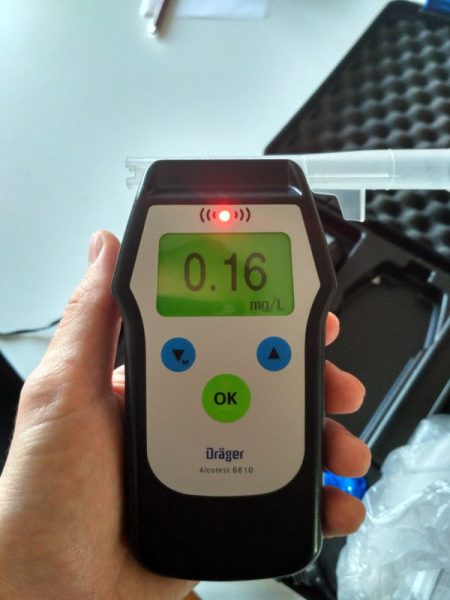
How much alcohol can you drink within the legal limit
The repeal of the "zero ppm" action was met with enthusiasm by most motorists. Many of them perceived this decision of the legislature as a permission to drive cars in a state of mild alcohol intoxication. In fact, this is not true at all. This decision of the authorities was made not to encourage drunk driving, but to avoid errors due to technical errors in measuring instruments and corruption of government officials.
It is difficult to answer the question of how much alcohol you can drink before driving. The fact is that the proportion of alcohol in the exhaled air, which is measured by breathalyzers of traffic police officers, depends on many factors. In addition to such obvious things as the amount of alcohol consumed and the strength of the drinks consumed, the following matters:
- Weight. With the same amount of alcohol drunk in a person with a large weight, the concentration of alcohol in the blood will be lower.
- Floor. In women, alcohol enters the blood faster and more intensively, and is excreted more slowly.
- Age and state of health. In a young healthy person, alcohol is more quickly excreted from the body and has a less tangible effect.
- Individual characteristics of the organism.
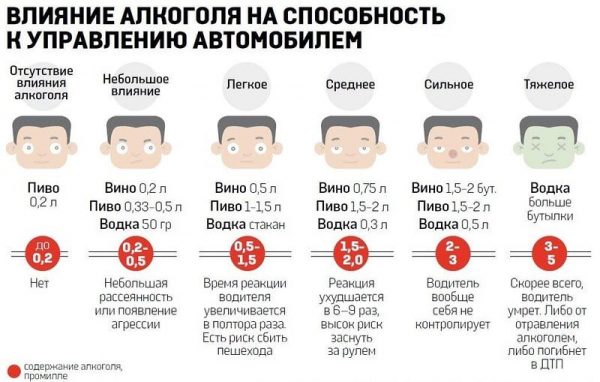
Only one conclusion can be drawn from this: there is no universal answer to how much alcohol a person can drink in order to remain within the law. However, there are some average indicators established empirically. For example, half an hour after drinking a small bottle of low-alcohol beer (0,33 ml), in most men of average build, the breathalyzer does not detect alcohol vapor in the exhaled air. At the same time, wine and drinks based on it turn out to be much more insidious in practice and “do not disappear” for a long time even when drinking one glass. After drinking strong alcoholic beverages, it is in no case recommended to drive. Even a shot of vodka or cognac will lead to unacceptable indicators during the test.
Video: about the number of ppm after drinking some alcoholic beverages
After which drugs alcohol is detected in the blood
Obviously, drugs prohibited for drivers include ethanol itself in its pure form, a copper alcohol solution, various pharmacy tinctures (motherwort, hawthorn and similar), as well as popular heart drops with the addition of ethanol (Valocordin, Valoserdin, Corvalol). There are some other drugs that have ethyl alcohol in their composition:
- Saledez;
- Salesept;
- Pichtanol;
- Sintomycin;
- Ingalipt;
- Bittner;
- Aflubin
- Aflubin
- Gentos;
- Pansoral.
In addition to those listed, there is another type of medicine that can cause an overestimation of the breathalyzer without alcohol in its composition. Among them: Novocain, Pertussin, Levomycetin, Mikrotsid, Etol.
The instructions for use for many medications contain categorical prohibitions on driving. This requirement may be dictated by various reasons. They can cause drowsiness, impair coordination, slow down a person's reaction, cause nausea, lower blood pressure, and other dangerous side effects.
The conclusion from what has been said is simple: read the instructions for the drugs you take. If they indicate a ban on driving a car or the content of ethyl alcohol in the composition, refrain from driving to avoid problems with the law.
The number of ppm in kvass, kefir and other products
In those three years, from 2010 to 2013, when the state banned even the minimum levels of alcohol in blood and exhaled air, many myths arose in society about how certain foods and drinks can contribute to disenfranchisement.
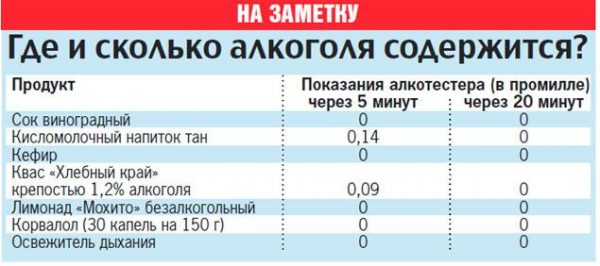

Indeed, many products contain small amounts of ethyl alcohol in their composition:
- overripe fruits (bananas);
- black bread;
- kvass;
- kefir and other fermented milk products;
- sweets stuffed with liquor;
- nonalcoholic beer.
The use of the products listed above cannot lead to a fine or disqualification. According to the results of numerous checks and tests arranged by our fellow citizens, these products, if they provoked an increase in ppm, completely disappeared within 10-15 minutes. Therefore, do not be afraid to consume soft drinks, sour-milk and other foods, as they will not lead to a violation of the law.
Video: ppm check after kvass, kefir, corvalol


Watch this video on YouTube
How is the amount of alcohol in the blood measured?
To measure the level of ethyl alcohol in the blood or exhaled air, the legislation of our country provides for a special procedure, which is designed to strike a balance between protecting others from drunk drivers and respecting the rights of motorists brought to administrative responsibility.
General concepts
To begin with, you should understand the basic terms when measuring the level of alcohol in the blood of a driver.
Examination for alcohol intoxication is the measurement of the level of alcohol by the traffic police inspector on the spot (either in the car or at the nearest post) using a breathalyzer.
A medical examination for alcohol intoxication is a measurement of the level of alcohol carried out by professional doctors in a medical institution by examining a person's blood. Simply put, an examination by a doctor.


The difference between the two given terms is huge: if the first of these procedures can be quite legally refused, then administrative liability is provided for refusing a medical examination under Art. 12.26 Administrative Code of the Russian Federation.
Certification procedure
The main documents from which you can learn about the procedure for examination are Decree of the Government of Russia No. 475 and a number of provisions from the Code of Administrative Offenses of the Russian Federation.
Examination for alcohol intoxication
Clause 3 of Decree of the Government of the Russian Federation No. 475 dated 26.06.2008/XNUMX/XNUMX exhaustively describes the grounds under which a traffic police officer may require an examination:
- the smell of alcohol from the mouth;
- posture instability;
- speech disorder;
- a sharp change in the color of the skin of the face;
- behavior inappropriate for the situation.
If none of the signs described above can be seen, then any survey is illegal.
The verification takes place in the following way:
- If at least one of the suspicious circumstances was noticed by the traffic police officer, he has the right to remove him from driving in accordance with 27.12 of the Code of Administrative Offenses of the Russian Federation. At the same time, for the correct suspension procedure, a protocol must be drawn up, a copy of which is handed to the driver. In addition, the law obliges to record the removal from the car on video or apply this measure in the presence of two witnesses (part 2 of the same article of the Code).
- Next, the inspector must offer to undergo an on-site examination, which you have the right to refuse.
- If you agreed to an examination by a traffic police officer, then be sure to make sure that the device has been certified and has the appropriate documentation. Also pay attention to the serial number on the breathalyzer, which must match the number in the documents, and the integrity of the seal on the device.
- If the breathalyzer showed acceptable values, then the suspension from driving can be considered removed, and you are free.
- If the breathalyzer showed an alcohol content in the exhaled air of more than 0,16 mg / l, then the inspector will draw up an examination certificate for the state of alcoholic intoxication. If you disagree with him, you can go for a medical examination.
- If you agree with the indicators of the breathalyzer, a protocol on an administrative offense and detention of the vehicle is drawn up, copies of which are also handed over to the driver without fail.


Medical examination for alcohol intoxication
A medical examination is the last resort in determining the amount of alcohol in the body. Further appeal of the procedure is possible only in court.
A medical examination is carried out in 3 cases (clause 10 of Resolution No. 475):
- refusal of an on-site examination;
- disagreement with the results of the examination by the driver;
- disagreement with the results of the survey on the part of the inspector.
Medical examination is carried out as follows:
- The traffic police inspector draws up a protocol on sending for a medical examination according to the form from the Order of the Ministry of Internal Affairs No. 676 of 04.08.2008/XNUMX/XNUMX.
- The procedure must be performed in a licensed health care facility by a properly trained physician. In the absence of a narcologist, this procedure can be carried out by ordinary doctors or even paramedics (subject to an examination in rural areas).
- The driver is asked to give urine. If the required amount of urine is not passed by the motorist, then blood is taken from a vein. In this case, the injection site should be treated without alcohol, which can distort the results of the study.
- Based on the results of the medical examination, an act is drawn up in triplicate. The form is established by Order of the Ministry of Health No. 933n.
- If even with the absence of alcohol in the blood established by doctors, the driver’s condition raises doubts, then the motorist is sent for a chemical-toxicological study.
- If the driver is confirmed to be under the influence of alcohol or drugs, then a protocol is drawn up on an administrative offense and the detention of the vehicle. Otherwise, the driver is free to continue driving his vehicle.
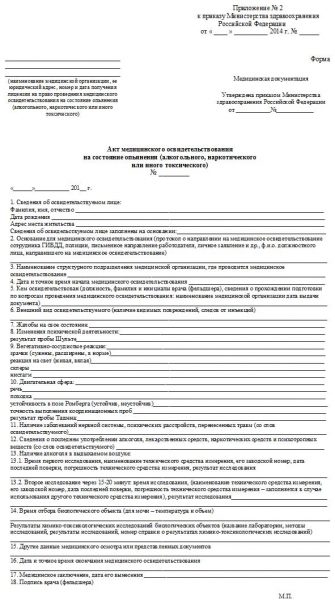

Breathalyzers used by traffic police officers during examination
Not any device capable of capturing alcohol vapors in exhaled air can be used by traffic police inspectors in their professional activities. The list of such technical means that are approved for use by Roszdravnadzor, as well as verified by Rosstandant, is contained in a special register.
Another prerequisite is the function of recording the results of the study on paper. As a rule, this entry looks like a cash receipt that appears directly from the device itself.
All of the strict requirements for instruments listed above are designed to guarantee the accuracy of the study and, as a result, the legality of the procedure.
The list of breathalyzers used by the traffic police is quite large. Here are just a few of them:
- Alcotest 6510;
- Pro-100;
- "Jupiter";
- "Alcotest-203";
- Lion-alcometer 500;
- Lion-alcometer SD-400.
Time to remove alcohol from the body
Often, on the morning after a party spent in good company with plenty of alcoholic drinks, a person is faced with the question of whether it is possible to go home in a private car or have to use a taxi. The average rate of alcohol excretion from the body is about 0,1 ppm per hour for men and 0,085–0,09 for women over the same period of time. But these are only general indicators, which are also affected by weight, age, and general health.
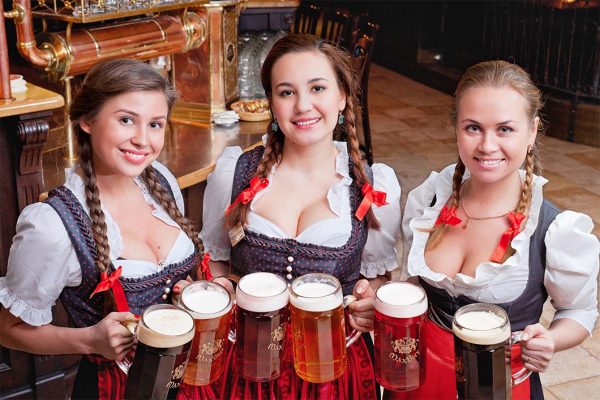

First of all, you should focus on your own inner feelings and logic before deciding whether to drive. In addition, you can use various programs and tables that allow you to roughly calculate when the alcohol is over.
A special alcohol calculator also gives an average result, but it allows you to enter data on the gender, amount and type of alcohol consumed, as well as body weight and the time elapsed since alcohol-containing substances entered the body. Such flexibility, as well as ease of use, have made such resources quite popular among motorists and just curious people.
Table: the time of purification of the human body from alcohol
| Person's weight/alcohol | 60 (kg) | 70 (kg) | 80 (kg) | 90 (kg) | Drink volume (grams) |
| Beer (4%) | 2.54 (h) | 2.39 (h) | 2.11 (h) | 1.56 (h) | 300 |
| Beer (6%) | 4.21 | 3.44 | 3.16 | 2.54 | 300 |
| Gin (9%) | 6.32 | 5.56 | 4.54 | 4.21 | 300 |
| Champagne (11%) | 7.59 | 6.50 | 5.59 | 5.19 | 300 |
| Port (19%) | 13.03 | 11.11 | 9.47 | 8.42 | 300 |
| Tincture (24%) | 17.24 | 14.55 | 13.03 | 11.36 | 300 |
| Liqueur (30%) | 13.03 | 11.11 | 9.47 | 8.42 | 200 |
| Vodka (40%) | 5.48 | 4.58 | 4.21 | 3.52 | 100 |
| Cognac (42%) | 6.05 | 5.13 | 4.34 | 4.04 | 100 |
How to quickly remove alcohol from the body
Existing methods for the rapid removal of alcohol from the body can be divided into 2 large groups:
- medical;
- "folk".
The first group of methods is carried out by professional doctors in inpatient treatment using special medications. Taking into account the condition of the patient and some other circumstances, the doctor prescribes treatment in the form of droppers and sorbent drugs that absorb harmful substances and accelerate the breakdown of ethanol. You should not “prescribe” drugs on your own, since a violation of the dosage can lead to poisoning and will only aggravate the state of intoxication.
The second group of methods is replete with various home finds and personal experiences of people. It is suggested to behave as follows:
- Drink more pure water.
- Sleep well (more than 8 hours).
- Do not be afraid to get rid of the contents of the stomach if necessary.
- Take a contrast shower.
- Take a walk, breathe fresh air to saturate the body with the necessary amount of oxygen.
Video: "folk" ways to remove alcohol from the body


Watch this video on YouTube
Penalty for drunk driving in Russia in 2018
Depending on the circumstances and severity of the act committed, a motorist may incur both administrative and criminal liability for driving while intoxicated.
Article 12.8 of the Code of Administrative Offenses of the Russian Federation provides for 3 offenses at once. Administrative responsibility for drunk driving consists in imposing a fine in the amount of 30 thousand rubles and deprivation of rights from 1,5 to 2 years. For the transfer of control of the car to a drunk passenger, the sanction is similar.
A more severe punishment is provided for drunk driving by a driver deprived of a license. For this violation, a person will be arrested for 10-15 days. Those who, due to their state of health or other reasons, cannot be arrested are fined 30 rubles.
Relatively new is Article 12.26 of the Code of Administrative Offenses, which equated the sanctions of refusing to undergo a medical examination to being intoxicated while driving. The punishment will be the same.
Despite the seriousness of the sanctions from the Code of Administrative Offenses of the Russian Federation, the most severe punishments are provided for by the Criminal Code. In article 264.1 of the Criminal Code of the Russian Federation, it is considered a crime to drive a car while intoxicated (refusal to be examined) by a person punished for the same violation. The punishment is very variable: a fine from 200 to 300 thousand rubles, compulsory work - up to 480 hours, forced labor - up to 2 years. The most severe punishment is up to two years in prison. Among other things, the criminal is additionally deprived of his rights for another 3 years. To be held liable under this article of the Criminal Code of the Russian Federation, he must commit a repeated violation during the period of conviction for the same crime (or within a year from the moment of violation of Articles 12.8 or 12.26 of the Code of Administrative Offenses of the Russian Federation (Article 4.6 of the Code).


Permissible blood alcohol level abroad
The legally established minimum level of alcohol content for a driver depends largely on the traditions of the country and the tolerance for alcohol in its culture.
The general norm for the EU is the content of pure alcohol up to 0,5 ppm. This rule is established in almost all European countries.
Stricter attitudes towards alcohol and driving are mainly concentrated in Eastern Europe and Scandinavia. For example, in the Czech Republic, Slovakia, Hungary, Romania.
On the contrary, a more loyal (up to 0,8 ppm) attitude towards alcohol consumption has developed in the UK, Liechtenstein, Luxembourg and San Marino.
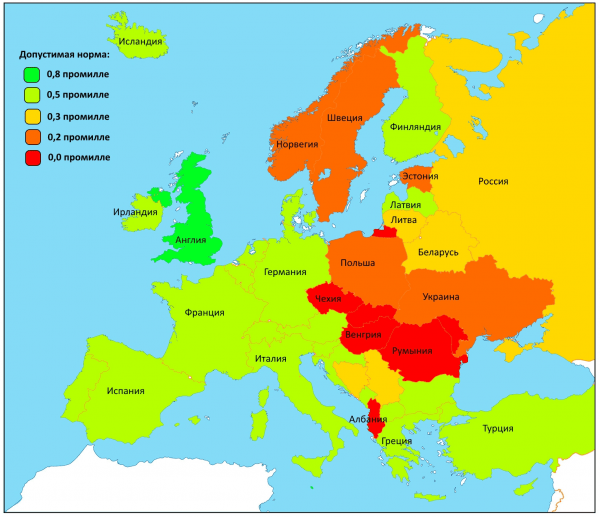

In North America, as a rule for drivers, the content of ethanol in the blood is not more than 0,8 ppm.
Eastern states are characterized by an uncompromising attitude towards drunk driving. For example, in Japan there is a zero ppm.
Thus, before driving to any foreign country, the driver should definitely learn more about its traffic rules, since sometimes they can be very different from the country of residence.
In Russia, for drivers, a fairly reasonable rate of per mille of alcohol in the blood is set: 0,3. Such an amount is not able to significantly affect the skills of a motorist and cause an accident. For drunk driving in our country severe punishment is provided up to imprisonment for up to two years. At the same time, on this issue, Russia does not get out of the global trend. Therefore, after a good party, it is better to use a taxi once again, and not drive.

